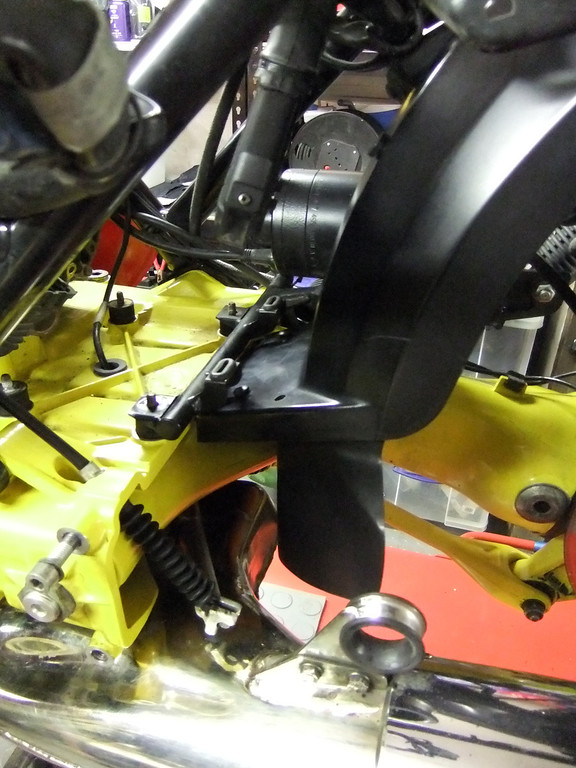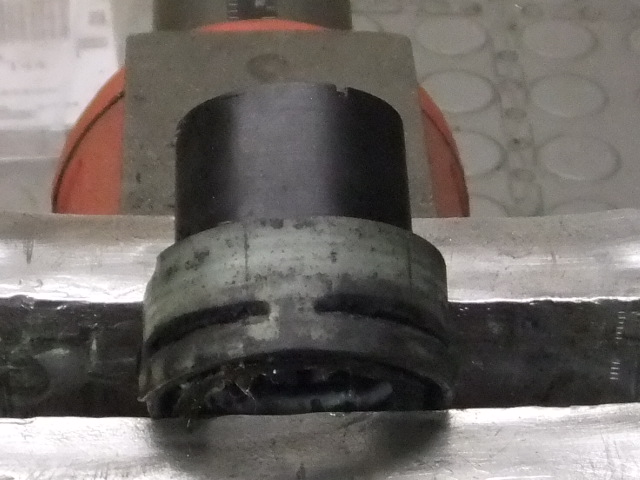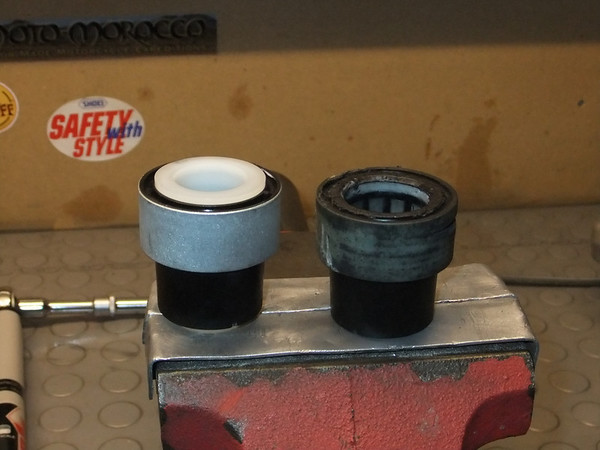1

 K100 or K75? Mon Feb 25, 2013 7:31 am
K100 or K75? Mon Feb 25, 2013 7:31 am
MikeP
Life time member

No. Not a competition, not a "which is best" but really a personal answer to a question raised elsewhere on the forum and not wishing to hijack an interesting thread.
First I'd best say that I have experience of both, find it impossible to decide which I prefer and in an ideal world would own (at least) one of each.
My first experience of a K75 was an 'S' owned by BMW(GB) that I collected from their UK HQ at Bracknell with under half a mile on the odometer and rode to what was then called the Transport Road Research Laboratory (TRRL) for the demo day of the then new ABS equipped K100LT.
This was one of each current models that BMW(GB) laid on for people to ride while the ABS equipped bike was being demonstrated and tested.
I'd ridden to Bracknell with a group of my colleagues who'd been invited to collect the demo fleet and to have a "play" on the TRRL circuit.
It was interesting to note that this K75S was the bike that was in most demand that day and at lunch-break, a colleague glanced at it as we walked past because it was pinging away as it cooled and gave off a smell that suggested it had been destroyed, I won't use his exact words but he gave me to think that he believed it would go back to Bracknell on a trailer.
It didn't, it was caned around all afternoon too and that was my introduction to the robust nature of the 750 triple.
Some while later, a bean-counter decided that a saving could be made where I worked by buying K75RTs instead of K100RTs. A small batch were purchased and I happened to be due to chop-in my K100 after three years and 80,000 miles. I was disappointed to find that I'd be given a K75 to replace it.
After saying goodbye to the trusty K100, I set off back to my base on the K75RT with every intention of hating it and blowing it up. I found that I could do neither but not for want of trying.
Over the next few months I discovered the delights of the K75 and in due course was sad to see it replaced by a K1100.
So apart from a cylinder missing and either 15 or 25 bhp down (8-Valve or 16-Valve depending), without going into the technical differences, what are the real world effects on use?
Well loss of one cylinder makes a bigger difference in the handling than might be imagined. It isn't just the loss of the pot, it's that the centre of the mass moves more towards the middle of the bike, even though the frame geometry is the same and other weight, such as the radiator, is mounted in the same place.
Nor can the difference be attributed to the forks as the K100s we had alongside the K75s used the same K75 suspension.
The difference in the handling is even more pronounced on the K75S and the lesser faired K75C or completely naked K75. Obviously the lack of that weighty fairing of the K100RT/LT or RS makes a difference but it doesn't explain it entirely. Even the K75RT feels more nimble (a relative term given that no K-Series is really very nimble).
When it comes to the engine and the missing horses, the difference in outright performance is less than the 15 bhp would suggest. It is a different matter with the 100 bhp 16-Valve K100s but still not massively so. This is more to do with the nature of the two engines. The K75 having a combined balancer/output shaft thrives on revs. There's a small step as you hit 6,000 rpm but not a huge one and even though it is rev-happy it still has excellent torque.
Wring its neck and a K75 will do everything short of 10 to 15 mph on the top end that an 8-Valve K100 will do.
It's certainly no drag bike and it needs more revs to pick-up its skirts than a K100 but having owned and ridden 8 and 16-Valve Ks, neither is as happy to be rev'd as a K75 in spite of the 'no flywheel' design being shared by the four and three cylinder engines.
Certainly here in the UK, the K75 suffered from an "entry level" or "poor man's" K-Series image. Sales never matched those of the four cylinder models. This was perhaps true of other markets too but the French in particular as well as the Germans themselves took to the triple. K75 models still sell well in France and Germany is a good source for under-used, high-spec models at reasonable prices.
Had the K75 been allowed to evolve in a similar manner to the four cylinder bike, we'd perhaps have seen a 900cc, 115-120 bhp, Telelever/Paralever machine in the end. I suspect that the reason why that didn't happen is because like with the earlier bikes, the triple was too close to the fours in performance leaving the former to suffer from "cylinder snobbery".
First I'd best say that I have experience of both, find it impossible to decide which I prefer and in an ideal world would own (at least) one of each.
My first experience of a K75 was an 'S' owned by BMW(GB) that I collected from their UK HQ at Bracknell with under half a mile on the odometer and rode to what was then called the Transport Road Research Laboratory (TRRL) for the demo day of the then new ABS equipped K100LT.
This was one of each current models that BMW(GB) laid on for people to ride while the ABS equipped bike was being demonstrated and tested.
I'd ridden to Bracknell with a group of my colleagues who'd been invited to collect the demo fleet and to have a "play" on the TRRL circuit.
It was interesting to note that this K75S was the bike that was in most demand that day and at lunch-break, a colleague glanced at it as we walked past because it was pinging away as it cooled and gave off a smell that suggested it had been destroyed, I won't use his exact words but he gave me to think that he believed it would go back to Bracknell on a trailer.
It didn't, it was caned around all afternoon too and that was my introduction to the robust nature of the 750 triple.
Some while later, a bean-counter decided that a saving could be made where I worked by buying K75RTs instead of K100RTs. A small batch were purchased and I happened to be due to chop-in my K100 after three years and 80,000 miles. I was disappointed to find that I'd be given a K75 to replace it.
After saying goodbye to the trusty K100, I set off back to my base on the K75RT with every intention of hating it and blowing it up. I found that I could do neither but not for want of trying.
Over the next few months I discovered the delights of the K75 and in due course was sad to see it replaced by a K1100.
So apart from a cylinder missing and either 15 or 25 bhp down (8-Valve or 16-Valve depending), without going into the technical differences, what are the real world effects on use?
Well loss of one cylinder makes a bigger difference in the handling than might be imagined. It isn't just the loss of the pot, it's that the centre of the mass moves more towards the middle of the bike, even though the frame geometry is the same and other weight, such as the radiator, is mounted in the same place.
Nor can the difference be attributed to the forks as the K100s we had alongside the K75s used the same K75 suspension.
The difference in the handling is even more pronounced on the K75S and the lesser faired K75C or completely naked K75. Obviously the lack of that weighty fairing of the K100RT/LT or RS makes a difference but it doesn't explain it entirely. Even the K75RT feels more nimble (a relative term given that no K-Series is really very nimble).
When it comes to the engine and the missing horses, the difference in outright performance is less than the 15 bhp would suggest. It is a different matter with the 100 bhp 16-Valve K100s but still not massively so. This is more to do with the nature of the two engines. The K75 having a combined balancer/output shaft thrives on revs. There's a small step as you hit 6,000 rpm but not a huge one and even though it is rev-happy it still has excellent torque.
Wring its neck and a K75 will do everything short of 10 to 15 mph on the top end that an 8-Valve K100 will do.
It's certainly no drag bike and it needs more revs to pick-up its skirts than a K100 but having owned and ridden 8 and 16-Valve Ks, neither is as happy to be rev'd as a K75 in spite of the 'no flywheel' design being shared by the four and three cylinder engines.
Certainly here in the UK, the K75 suffered from an "entry level" or "poor man's" K-Series image. Sales never matched those of the four cylinder models. This was perhaps true of other markets too but the French in particular as well as the Germans themselves took to the triple. K75 models still sell well in France and Germany is a good source for under-used, high-spec models at reasonable prices.
Had the K75 been allowed to evolve in a similar manner to the four cylinder bike, we'd perhaps have seen a 900cc, 115-120 bhp, Telelever/Paralever machine in the end. I suspect that the reason why that didn't happen is because like with the earlier bikes, the triple was too close to the fours in performance leaving the former to suffer from "cylinder snobbery".






















